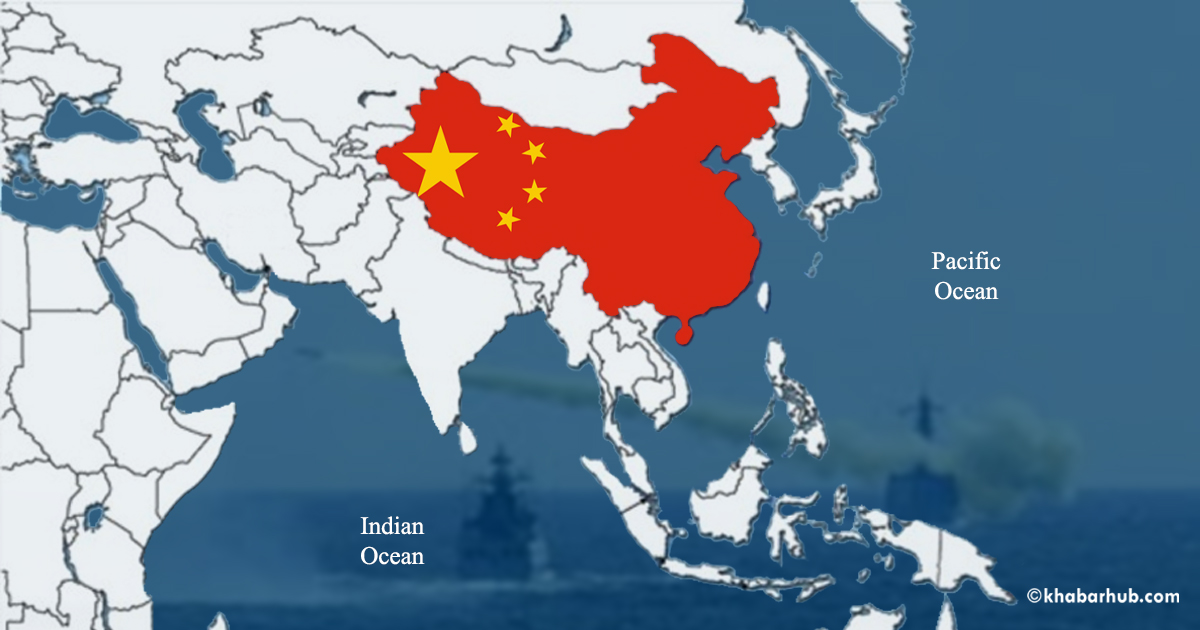China’s military rise is a stepping stone toward China’s dream for global power, which inevitably poses a security threat to nations in the Indo-Pacific region.
This study uses the theoretical base of structural realism’s component of “offensive realism and defensive realism.”
China’s doctrine of “offshore waters defense” with “open seas protection” enhances its comprehensive defense, counterattack, and deterrence capabilities near its territory and overseas maritime domain.
However, China’s naval modernization, establishing overseas naval base, and militarization of ports represents security threats to countries in the Indo-Pacific region.
China’s military deployments in the South China Sea (SCS) and its missile capabilities pose security threats to India’s mainland and maritime security in the Indo-Pacific region.
China’s energy requirements rely on the import of oil and natural gas through the Indian Ocean and Eastern Siberia–Pacific Ocean (ESPO) pipelines from Russia, but Beijing’s major energy transportation and maritime trade route transits through the Indian Ocean region.
India’s maritime influence in Indian Ocean region starts from the Gulf of Aden to the Straits of Malacca. To gain parity in the region, China has established an overseas military base in Djibouti and developed a port in Hambantota, Sri Lanka.
Therefore, to protect sea lines of communication (SLOC), China has established ports across the Indo-Pacific in addition to its overseas naval base in Djibouti.
China’s Belt and Road Initiative (BRI) provides benefits to the countries along its route. Additionally, the initiative fulfills Beijing’s global trade ambitions and energy requirements and supports China’s establishment of overseas military bases.
To generate maritime connectivity, over the last decade China financed 35 ports around the world, out of which 14 ports are located throughout the Indian Ocean region and three ports are in the Pacific Ocean.
More than 85 percent of China’s oil import is transported across the Indian Navy–guarded Indian Ocean and passes through the Straits of Malacca. China’s Maritime Silk Road (MSR) mainly involves the SCS region and the Indian Ocean region. China needs to protect its SLOCs across these regions.
To build a powerful navy for the protection of seaborne transportation, strategic passageway for energy supplies, and exploitation of resources in international waters, the People’s Liberation Army Navy (PLAN) has pursued a rigorous regime of modernization.
India’s maritime influence in Indian Ocean region starts from the Gulf of Aden to the Straits of Malacca. To gain parity in the region, China has established an overseas military base in Djibouti and developed a port in Hambantota, Sri Lanka.
China also developed the port of Kuantan port on the east coast of Malaysia, which connects the SCS and the Indian Ocean.
These ports and overseas military bases are strategically located on the sea lane of the MSR, encroaching upon India’s maritime domain. This causes greater strategic deterrence for India’s maritime security in the Indian Ocean.
China’s Defense and Offensive Capability to Secure the Maritime Silk Road in the Indo-Pacific Region
The state of advancements in technology is the vital point of offense as well as defence for attrition and strengthening China’s security.
To secure its global trade and exploit energy resources, Beijing is building its military’s offensive and defensive powers in the Indo-Pacific region and expanding it blue water naval might.
Hence, China is determined to increase its number of nuclear-powered submarines, ballistic missile launch submarines (SSBN), aircraft carriers, surface combat ships, intercontinental ballistic missiles (ICBM), medium-range ballistic missiles (MRBM), and combat aircraft to strengthen its comprehensive security in the Indo-Pacific region.
To increase maritime capability, China commissioned a domestically designed and produced aircraft carrier, the Shandong, which entered service in 2019.
This section investigates Chinese deployments in the SCS and its arms capabilities that deter New Delhi and India’s allies in the Indo-Pacific region.
The militarization of artificial islands in the natural resource–rich SCS through the establishment of air force bases and naval dockyards in the Spratly Islands (Subi Reef, Fiery Cross Reef, and Mischief Reef) and Paracels (Woody Island) pose security threats to neighboring countries in the region.
In May 2016, the PLAN conducted extensive naval deployments in the SCS, Western Pacific, and in the eastern Indian Ocean.
Also, a PLAN task force conducted maritime interdiction training in the Indian Ocean region. In December 2016, the PLAN’s first aircraft carrier, Liaoning, conducted a task-group integration training exercise in the SCS region.
To increase maritime capability, China commissioned a domestically designed and produced aircraft carrier, the Shandong, which entered service in 2019.
Additionally, the PLAN’s first nuclear-powered aircraft carrier will likely enter service by 2025. This latter aircraft carrier will greatly enhance China’s naval capability for blue water naval operations, strengthening its maritime defense power to protect its MSR initiatives in the Indo-Pacific and Arctic regions.
Eventually, China plans to field four aircraft carriers into PLAN service by 2030, with an advanced electromagnetic catapult to launch aircraft from the carrier deck.
China is significantly ahead of India’s aircraft carrier program; although, India’s three aircraft carriers currently under construction will probably come into operation roughly the same time as China’s new carrier are slated to roll out for the PLAN.
To protect natural resources and promote Beijing’s stance on the many maritime territorial dispute with China’s neighbors in the SCS, the PLAN deployed more naval forces in the South Sea fleet equipped with Jin-class SSBNs, Shang I-class nuclear attack submarines, and missile patrol craft, when compared to its North and East Sea fleets.
Also, the PLAN categorizes its theater missile defense (TMD) as a layered maritime defensive system to provide offensive and defensive security challenges in the East China Sea and SCS regions.
Beijing’s defensive layer ranges from 540 to 1,000 Nautical miles (nm), which covers Japan, the SCS, the Philippines, Brunei, and the Straits of Malacca strait.
These regions are patrolled by submarines and occasionally engaged by anti-ship ballistic missiles for long-range maritime strike in this region to strengthen China’s antiaccess/area denial (A2/AD) capability in the SCS region.
It also strengthens the offensive capability of China through the air without flying over air defence identification zones (ADIZ) of other countries; thus, avoiding the need for authorization of overflight rights and evading missile defense systems, such as Vietnam’s Russian-made surface-to-air S-300 antiaircraft missile system.
As part of China’s military exercises and practice of militarizing islands in the SCS, the People’s Liberation Army Air Force (PLAAF) landed a H-6K nuclear-capable, long-range strategic bomber on Woody Island.
This bomber carries six electro-optic or infrared imaging guided air-launched cruise missiles capable of precision striking.
The H-6K’s strike range is enhanced from the base 3,500 km–range to a heightened 5,000 km–range by the incorporation of the CJ-20 air-launched Land-Attack Cruise Missile (LACM) for conventional/nuclear strike.
From the SCS, the CJ-20 is capable of reaching Singapore, Thailand, the Philippines, Vietnam, Indonesia, and Malaysia in the first island chain.
The missile plays a vital role for China in the SCS region, as it helps to overcome refuelling of combat aircraft from its nearest air bases from outposts in the SCS.
It also strengthens the offensive capability of China through the air without flying over air defence identification zones (ADIZ) of other countries; thus, avoiding the need for authorization of overflight rights and evading missile defense systems, such as Vietnam’s Russian-made surface-to-air S-300 antiaircraft missile system.
Additionally, China’s man-made islands in the SCS equipped with DF-15 short-range ballistic missiles, HQ-9B surface-to-air missiles, and a ground-launched variant of the YJ-12B missile, which, along with H-6K strategic bomber, pose significant threats to India’s maritime trade with Association of Southeast Asian Nations (ASEAN) countries across the region.
To strike highly secured and military significant targets, China developed the DF-ZF hypersonic glide vehicle (HGV), through ballistic missile boosters.
HGVs can pull-up after reentering the atmosphere and approach the target in a relatively flat glide, lessening the time it can be detected, fired at, or reengaged if an initial attack fails. Gliding makes the weapon more maneuverable and extends its range.
The People’s Liberation Army Rocket Force (PLARF) tested the DF-17 MRBM for carrying the DF-ZF to deliver both conventional and nuclear payloads against targets. The DF-ZF is expected to become operational in 2020.
This weapon system is capable of reaching the Andaman Sea and Straits of Malacca, if it strategically operated from Hainan Island in China’s southern theater command.
It could also reach Visakhapatnam and the Bay of Bengal region if it strategically operated from Xizang in China’s Western theater command.
THE HGV travels with hypersonic speed and could reach a maximum terminal velocity of Mach 10, which makes it challenging for conventional missile defense systems to intercept at the terminal phase of flight.
With high impulse, it is capable of penetrating to intercept aircraft carriers or unmanned warships and ultimately destroy the targets accurately and quickly, before command and control, battle management, and communication (C2BMC) reacts to determine its optimized trajectory for target destination.
This HGV will deter India’s naval presence across the Indo-Pacific region.
China deployed the DF-26 intermediate-range hip ballistic missile for conventional or nuclear strike within the range of 4,023 km, which is capable of a precision strike on surface combatants far from the Chinese coast.
This weapon strengthens China’s theater missile defense in the Pacific region. If this dual-use DF-26 is strategically operated from Hainan Island to attack land targets, it is capable of reaching the central region of India, the entire eastern coast of India, the Straits of Malacca, and Guam in the Pacific Ocean.
Furthermore, China is developing next-generation tactical nuclear weapons, which are capable of devastating designated targets in the Indian Ocean littoral region.
China’s advanced hyperspectral imaging satellite (able to scan the different nature of object using a wide band of the electromagnetic spectrum) with incorporation of command, control, communications, computers, intelligence, surveillance, and reconnaissance (C4ISR) will support ballistic, cruise missiles, and antiship ballistic missiles (ASBM) for precision-strike on moving targets (aircraft carriers and surface combatants) in the Indo-Pacific region.
To strengthen long-range offensive striking capabilities, China developed the strategic CSS-X-20/Dong Feng 41 (DF-41) ICBM with a range of 12,000 km to 15,000 km.
It is capable of carrying 10 multiple independent re-entry vehicles (MIRV) with a conventional or nuclear payload capacities of 2,500 kg.
Its nuclear warheads can yield up to 150 Kiloton on each MIRV. The DF-41 operated from China’s Western theater command is capable of reaching the central part of India in less than five minutes or striking any location in India and the Indo-Pacific region.
Furthermore, China is developing next-generation tactical nuclear weapons, which are capable of devastating designated targets in the Indian Ocean littoral region.
PLAN Submarines and Surface Combat Capability to Protect MSR in the Indo-Pacific Region
The PLAN modernized its Type-093 nuclear-powered attack submarines to carry YJ-18 submarine-launched antiship cruise missiles to countermeasure enemies’ destroyers and missile threats.
Additionally, China has deployed more PLAN submarines to patrol and secure its SLOCs. The PLAN currently has two Shang I-class (Type-093) SSNs, four Shang II-class attack submarines (Type-093A) with acoustic quietening technologies to reduce the noise for stealth mode of operation, and four Jin-class (Type-094) SSBNs.
According to a United States Department of Defense report, the latter sub can carry 12 JL-2 nuclear-armed SLBMs and has a strike range of 7,400 km.
With this striking range, the JL-2 is capable of reaching any location in India, Australia, and naval bases in the Indian Ocean region, as well as certain parts of Alaska.
Next, the PLAN’s next-generation Type-096 SSBN will likely be commissioned in 2020 and is expected to be armed with armed with next-generation JL-3 SLBMs.
Thus, in 2020, the PLAN submarine inventory is expected to include 58 submarines, of which 48 are SSK-Diesel-electric power submarines and 10 are nuclear-powered submarines.
Compared to China, India has less than half the number of conventionally powered and nuclear-powered submarines.
To avoid human errors and enhance faster response under crucial situations, China is developing artificial intelligence for navigation and combat-control actions for its submarines, aimed at making appropriate decisions without human intervention. By 2020, most of the PLAN’s submarines will be armed with advanced long-range ASBMs.
The PLAN has a plethora of surface combatants to patrol and protect its aircraft carriers, including Type-054A frigates; Type-056 and Type-056A corvettes; and Type-052B, Type 052C, and Type-052D destroyers.
Nevertheless, to prove China’s maritime superiority in the Indo-Pacific region, Beijing developed Asia’s largest surface combat vessel: the Type-055 destroyer, a class of stealth guided missile destroyers designed for multimission roles, including area air defense and antisubmarine warfare capabilities surpassing previous Chinese surface combatants.
At present, four Type-055 destroyers are in service. The PLAN has equipped these ships with 112 universal canister-based vertical launch missile modules to strike targets at various ranges from hundreds to thousands of kilometers, utilizing YJ-18 long-range ASCMs (with up to a 500 km-range to strike the target at supersonic velocity of Mach 3), HHQ-9 surface-to-air missiles (with a maximum 100 km-range), and CJ-10 land-attack cruise missiles (with target maximum range of 2,000 km), and torpedo-carrying antisubmarine missiles.
To destroy the target in the range of 100 nautical miles, China is looking to incorporate electromagnetic rail guns into warships to fire the warheads with the hypersonic velocity of Mach 7, enabling them to destroy targets with high momentum at a longer distance.
This hypersonic naval gun will likely be fielded on the Type-055A destroyer, which is expected to enter service by 2025.
To compete with global maritime powers, China has announced plans to build 500 warships by 2030, this could elevate the PLAN to be the strongest naval power in Indo-Pacific region.
Though China’s neighbors are increasing their A2/AD capabilities, China keeping pace with its commitment to develop advanced military technologies.
The PLAN is improving its over-the-horizon (OTH) radar, which uses low-frequency electromagnetic waves to reflect off the ionosphere and travel over a long distance beyond the horizon with less attenuation to detect long-range targets. OTH radar can support China’s early warning systems.
Additionally, the PLAN is developing reconnaissance satellites, which are capable of locating the target over thousands of kilometers and support China’s long-range precision strike of targets from its mainland.
Development of the DN-3 exo-atmospheric HGV hit-to-kill missile interceptor, real-time surveillance capabilities, reconnaissance, cruise missiles, PL-15 long-range air-to-air missile, ASBMs, multi-kilowatt fiber optic strategic laser weapons, new-generation surface combatants, and microwave weapons strengthen China’s A2/AD capability to defend threats from neighboring regions.
Chinese defense agencies will probably implement these developments in advanced quantum technology in the Strategic Support Force (SSF), combat control, ballistic missile defense (to identify the nature of warheads), and maritime navigation for naval ships.
In addition to the aforementioned defense technology developments, China is committed to developing quantum information technology for unhackable data transfer in cyberspace for secure communications. In August 2016, China launched the world’s first quantum satellite: the Quantum Experiments at Space Scale (QUESS).
The following year, China successfully carried out the first communication by using quantum encrypted messages with entangled photons for secure communication.
This pioneering work led to the building of the world’s first quantum network between Beijing and Shanghai for secure communication.
Quantum encryption ensures that efforts to tamper with communications are instantly known by sender and receiver alike, using quantum key distribution, and alters the content of the message being sent.
China aims to build its quantum key distribution for quantum communication network by 2020 and for global communication by 2030.
Additionally, QUESS will be a useful to perform space-scale tests on photon teleportation experiments, establishing quantum networks at space-scale to transfer entangled photons for unhackable secure communication around the globe.
Chinese defense agencies will probably implement these developments in advanced quantum technology in the Strategic Support Force (SSF), combat control, ballistic missile defense (to identify the nature of warheads), and maritime navigation for naval ships.
(To be continued)
(Thangavel K. Balasubramaniam is a doctoral candidate at the Department of Politics and International Studies, Pondicherry University, India; and Ashok Kumar Murugesan is a doctoral candidate at the Department of Physics, Pondicherry University, India)









Comment